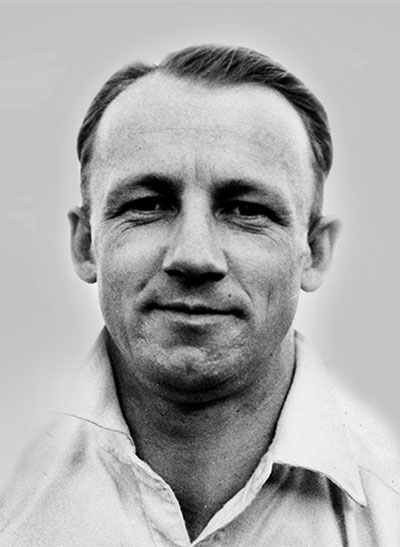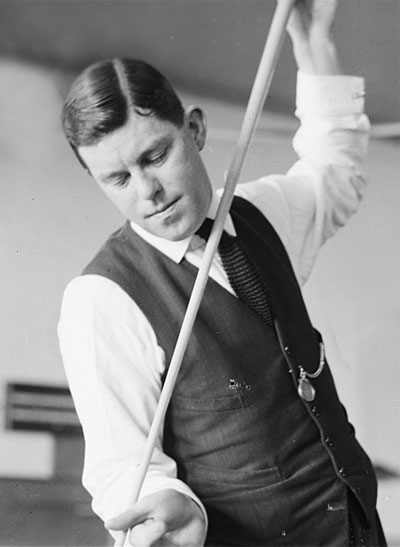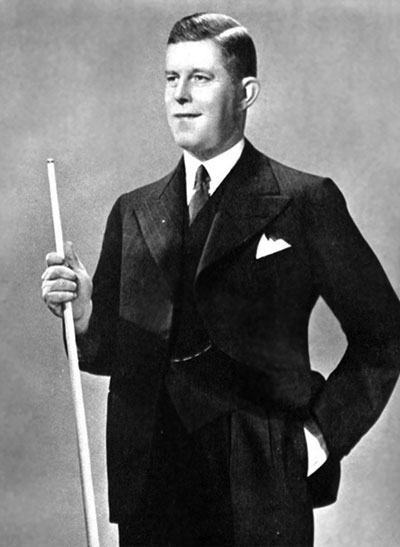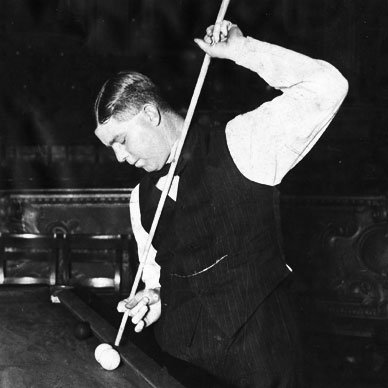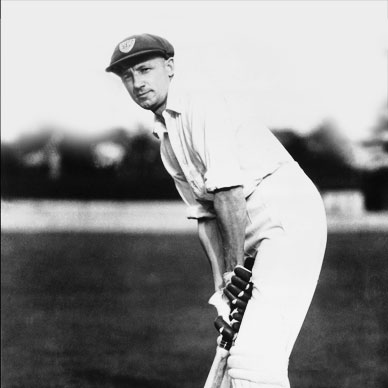- ‹
- ›
Walter Lindrum OBE and Sir Don Bradman
There will probably always be disagreement as to the amount Lindrum raised during the war years. There is surely no dispute, though, that Lindrum's selfless deeds must rank as a most remarkable contribution to the welfare of his nation. – Lindrum's biographer Andrew Ricketts
No other champion of billiards or any other sport was ever asked to give way a start in a world championship event, yet Lindrum had to. Fact that even after giving a start he still won, only proved his true greatness. – Lindrum — Magic Name in World Billiards (1949, May 5) Northern Times
Lindrum has been called the 'Bradman of Billiards'. He was far more than that, the Bradman-Trumper-Grace-Hobbs combined. – Great Moments in Australian Sport, by R.S. Whitington
Lindrum was, simply, a genius who conquered his sport more thoroughly than any other player has conquered any other. – Cue Sport Commentator Clive Everton
For many years he employed his gifts most generously in the sesrvice of the nation. No good cause ever applied to him in vain. He raised by exhibition games enormous sums of money for public and charitable ends. He was, for all these reasons, a great sportsman and a most patriotic citizen.
He had an engaging personal modesty and charm. He was himself in any company. Walter is a good man in every way.
– Former Australian Prime Minister Robert Menzies
His performances in England in 1930, right at the heart of the depression, gave the nation hope. Of course it carried on until 1948 when he retired. He was seen as someone of enormous integrity. He wrote 80 letters a day, four hours a day. – Bradman's biographer Roland Perry
It is estimated one million fans have received hand-written replies from Bradman. (What they said about The Don | cricket.com.au)
He is probably the most important Australian of all time." – Legendary Commentator and former Australian cricket captain Richie Benaud
He was a great player and inspiration to millions of people, including myself. His statistics are mind blowing and it's difficult to put in context - he was a once-in-a-lifetime player and his contribution off the field is significant as well. – Former Australian cricket captain Steve Waugh
Isn't that Don Bradman over there? I would like to be introduced. – Winston Churchill
He reminded Australians that they were capable of great things in their own right. He was the greatest, nobody will be anywhere near him. He was a hero to me as a young child and he remained a hero to me all of my life.
Discomforted as he was by fame, no other sporting hero had contributed so much to the Australian public’s pride and sense of nationhood.
– Former Australian Prime Minister John Howard
Walter Lindrum and Donald Bradman are two iconic figures in Australian sports, each excelling in their respective fields. Both rose to stardom on their first visits to England, Lindrum with his record break of 3262 and 67 breaks over 1000 (more than any other player had achieved in a lifetime) in his 1929-1930 English Billiards season, and Bradman with his record innings of 334 and an astounding batting average of 139.14 in the 1930 Ashes cricket series. Their journey from prodigies to global sensations is a testament to their unmatched talent, relentless work ethic, and enduring passion for their individual sports.
We will now explore and compare some interesting parallels between the two critically acclaimed Australian sporting heros.
Walter Lindrum
Name: Walter Albert Lindrum OBE, fondly called “Wally“, referred to as”Bradman of Billiards”
Born: Kalgoorlie, Western Australia (29 August 1898 – 30 July 1960, aged 61)
Professional: 1911-1950
Sport: Billiards. Lindrum is considered the greatest player of all time, with accolades including: 57 world records, multiple World Professional Billiards titles, and a highest break of 4,137, which still stands as a world record today.
Greatest Comeback: Trailing by 9177 points, Lindrum fought back to win the 1931–1932 International Gold Cup Tourney against Tom Newman (receiving a 7,000 start). The final session is described as the greatest billiards event ever staged, with the victory earning him a special invitation to perform for King George V and Queen Mary.
Career:
Lindrum showed great passion and promise for cricket in his early teens, scoring many centuries for his school, and spent plenty of time playing it when away from the billiards table. Having had to make a difficult choice between billiards and cricket, he ultimately followed his father’s command to choose billiards, leaving school and becoming professional at 14. As the ‘Boy Wonder’ at 15, he began his first major tour with Miss Ruby Roberts, the ‘Lady Billiards Champion’, eventually elevating his billiards prowess to become the most amazing wizard of the cue. In his late career and retirement, Lindrum devoted himself to exhibition matches, raising substantial funds to help the war effort and various charities.Don Bradman
Name: Sir Donald George Bradman AC, nicknamed “The Don“, referred to as”Lindrum of Cricket”
Born: Cootamundra, New South Wales, Australia (27 August 1908 – 25 February 2001, aged 92)
Professional: 1927-1949
Sport: Cricket. Bradman is considered the most prolific cricketer of all time; holds the highest career batting average in Test cricket (99.94), which remains unrivalled.
Greatest Comeback: In his first two matches as captain in the 1936 Ashes, Bradman was dismissed twice without scoring, inciting a public outcry to remove his captaincy. In a remarkable turnaround, Australia won the last three Tests, with Bradman scoring 270, 212, and 169. It was the first and only time that a team had come back from two-nil down to win an Ashes series.
Career:
While Bradman’s cricketing skills were on the rise, he was also a prodigious tennis player. Deciding between the two sports, he gave up cricket for tennis at 14 after leaving school, but returned to cricket shortly. At 19, he scored 118 runs on his first-class debut. The natural self-taught ‘Boy from Bowral’ soon became the most legendary magician at the crease. After retiring as a player, he excelled in every venture, being a champion golfer and squash player, a stockbroker, and an influential cricket administrator.Bradman was also a keen and talented billiards player. He attended Lindrum and Faulkiner’s match at Thurston Billiards Hall in London on 19 September 1930, and the two had a friendly game. Many claimed that after daily practice for a year, Bradman challenged Lindrum for a rematch in his Adelaide home’s billiards room and matched him.
More Parallels
Lindrum and Bradman are known for their indomitable success in their respective sports. Walter Lindrum held numerous world records and was considered the finest player the world has ever seen. Don Bradman is widely regarded as the best cricketer of all time, with his Test batting average of 99.94 being a record that stands head and shoulders above any other player in cricket. 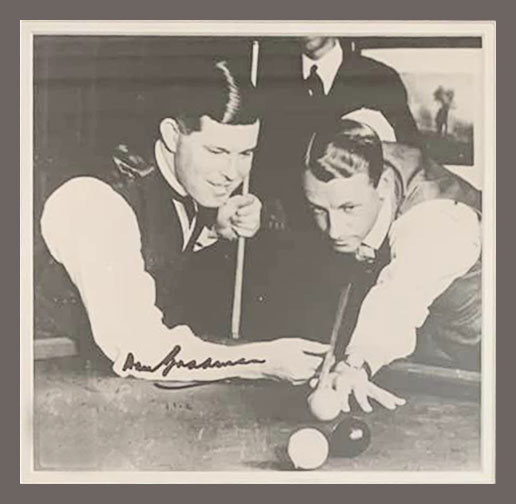 Both also prided themselves on dominance and longevity, being the world’s best throughout careers spanning multiple decades. A key component of their success was continuous innovation in their skills. Lindrum was known for introducing innovative techniques and strategies to the game, including the use of side spin and precise cue ball control. Bradman was known for his unique batting technique and incredible hand-eye coordination, which allowed him to dominate bowlers in his era.
Both also prided themselves on dominance and longevity, being the world’s best throughout careers spanning multiple decades. A key component of their success was continuous innovation in their skills. Lindrum was known for introducing innovative techniques and strategies to the game, including the use of side spin and precise cue ball control. Bradman was known for his unique batting technique and incredible hand-eye coordination, which allowed him to dominate bowlers in his era.
Both also had to overcome external forces attempting to weaken their dominance. Due to Lindrum’s supreme skill, especially in the “nursery cannons” technique, which involves gathering the balls close together in a way that allows the player to score repeatedly without moving the balls much, he was able to amass huge breaks and scores. In an attempt to limit this high-scoring technique, the Billiards Association and Control Council (B.A. & C.C.) trialled the baulk-line rule, where the cue ball must cross it at least once every 200 points in a break. Lindrum soon mastered the baulk-line rule and won the World Championship in 1933. Bradman’s duel was with Bodyline, also known as fast leg theory bowling, an aggressive bowling tactic employed by the England cricket team captained by Douglas Jardine during the 1932–1933 Ashes series against Australia. The primary intention was to limit Bradman’s scoring opportunities. By consistently bowling at or near his body, they could restrict his ability to play leg-side shots, leading to more dismissals. Bradman’s batting was affected. Nonetheless, he adapted his batting technique and had some success against the Bodyline tactic.
Their legacies are unquestionably significant. Lindrum played a key role in popularizing the game through exhibition matches and record-breaking performances, and his effort of about 4,000 charitable exhibition matches during and after the war is claimed to have raised more funds than any other athlete. Bradman’s transcends cricket, being recognised globally as a symbol of cricketing excellence. His famous one-line statement: “We will not play them (South Africa) until they choose a team on a non-racist basis.” in the cancellation of apartheid South Africa’s Australian tour in 1971 stood as his most important legacy. After Bradman’s passing, Mandela paid tribute to him on television, stating “he was a hero, a true hero.” The Bradman Museum and International Cricket Hall of Fame in Bowral, New South Wales, is dedicated to his memory. Both were known for their sportsmanship, humility, the positive influence they had on their respective sports, and their impact on future generations of athletes.
Walter Lindrum and Don Bradman are remembered as two of Australia’s most beloved and revered sports legends. Their names continue to be synonymous with excellence in their respective disciplines. Lindrum and Bradman are luminaries that will never cease to shine brightly in the pantheon of sporting legends. Their legacy continues to inspire and captivate enthusiasts worldwide.
References
- Ricketts, A. (1982) Walter Lindrum: Billiards Phenomenon. 1st edn. Manuka, A.C.T.: Brian Clouston.
- Perry, R. (2008) The Don’s finest declaration, The Age. Available at: https://www.theage.com.au/sport/cricket/the-dons-finest-declaration-20080823-ge7c73.html (Accessed: 25 October 2023).
- Don Bradman (2023) Encyclopædia Britannica. Available at: https://www.britannica.com/biography/Don-Bradman#/media/1/76845/253068 (Accessed: 25 October 2023).
- Cricket-Australia (2015) What they said about the Don, Home. Available at: https://www.cricket.com.au/news/3267548/what-they-said-about-the-don (Accessed: 25 October 2023).
- By Unknown author - http://www.leski.com.au/catalogues/a301/TCRI.php, Public Domain, https://commons.wikimedia.org/w/index.php?curid=2590804



